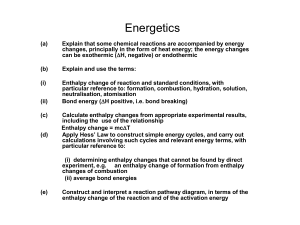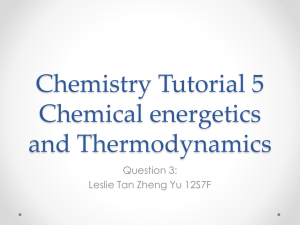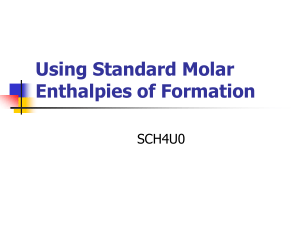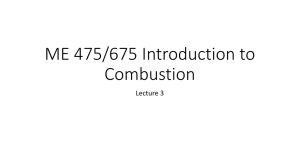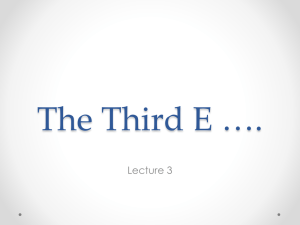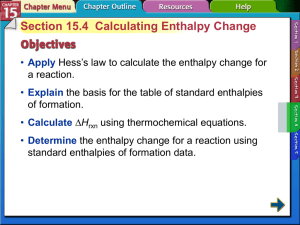Enthalpy Changes - chemnotes.org.uk
advertisement
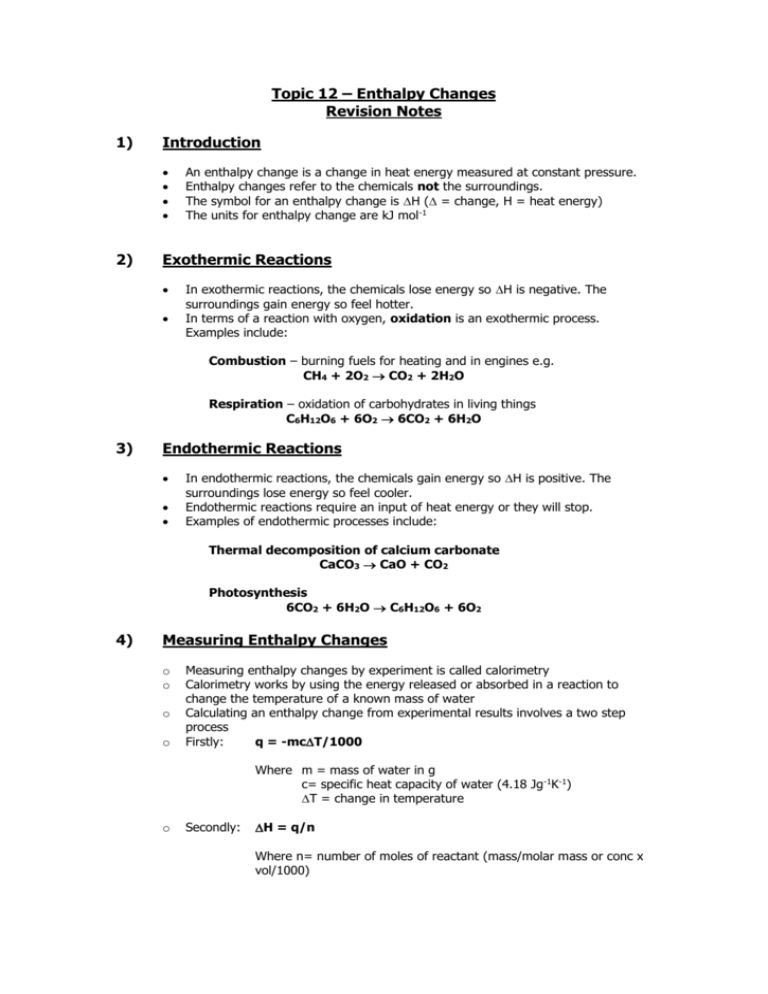
Topic 12 – Enthalpy Changes Revision Notes 1) Introduction 2) An enthalpy change is a change in heat energy measured at constant pressure. Enthalpy changes refer to the chemicals not the surroundings. The symbol for an enthalpy change is H ( = change, H = heat energy) The units for enthalpy change are kJ mol-1 Exothermic Reactions In exothermic reactions, the chemicals lose energy so H is negative. The surroundings gain energy so feel hotter. In terms of a reaction with oxygen, oxidation is an exothermic process. Examples include: Combustion – burning fuels for heating and in engines e.g. CH4 + 2O2 CO2 + 2H2O Respiration – oxidation of carbohydrates in living things C6H12O6 + 6O2 6CO2 + 6H2O 3) Endothermic Reactions In endothermic reactions, the chemicals gain energy so H is positive. The surroundings lose energy so feel cooler. Endothermic reactions require an input of heat energy or they will stop. Examples of endothermic processes include: Thermal decomposition of calcium carbonate CaCO3 CaO + CO2 Photosynthesis 6CO2 + 6H2O C6H12O6 + 6O2 4) Measuring Enthalpy Changes o o o o Measuring enthalpy changes by experiment is called calorimetry Calorimetry works by using the energy released or absorbed in a reaction to change the temperature of a known mass of water Calculating an enthalpy change from experimental results involves a two step process Firstly: q = -mcT/1000 Where m = mass of water in g c= specific heat capacity of water (4.18 Jg-1K-1) T = change in temperature o Secondly: H = q/n Where n= number of moles of reactant (mass/molar mass or conc x vol/1000) o o o Enthalpy changes measured from calorimetry are smaller than the expected values because of heat loss to the apparatus and the environment Other reasons for differences from standard values are non-standard conditions and evaporation of water In the case of measuring enthalpies of combustion, differences from standard values can occur through incomplete combustion and evaporation of the fuel (if it is a liquid) Example The combustion of 0.15g of ethanol, C2H5OH, in a spirit burner increased the temperature of 75 cm3 of water by 12.5C. Calculate the enthalpy of combustion of ethanol in kJ mol -1. 5) q = -mcT/1000 = -75 x 4.18 x 12.5/1000 = -3.919 kJ n = 0.15/46 = 3.26 x 10-3 mol H = -3.919/3.26 x 10-3 = -1202 kJ mol-1 Enthalpy Changes The standard conditions for measuring enthalpy changes are a pressure of 100 kPa and a temperature of 298K. Standard enthalpy changes are indicated by the symbol Enthalpy change of reaction, HR, is the enthalpy change when the reaction occurs in the molar quantities shown in the chemical equation Enthalpy change of combustion, Hc, is the enthalpy change when one mole of a substance is completely burnt under standard conditions e.g. C5H12(l) + 8O2(g) 5CO2(g) + 6H2O(l) Some substances cannot be burnt and have zero enthalpy of combustion e.g. O 2, CO2, H2O Enthalpy change of formation, Hf, is the enthalpy change when one mole of a substance is formed under standard conditions e.g. 5C(s) + 6H2(g) C5H12(l) Hf for elements is zero It is difficult to measure Hf for hydrocarbons because carbon and hydrogen do not react readily and other hydrocarbons will be formed in addition to the one of interest 7) Enthalpy Profile Diagrams 8) These diagrams show the difference in enthalpy between the reactants and products. Average Bond Enthalpy This is the energy needed to break one mole of gaseous bonds Example equation: H2(g) 2H(g) For a bond such as C-H that is found in many compounds, the value given in the data book is an average over many compounds containing the bond Average bond enthalpies have a positive sign because energy is needed to break a bond 9) Calculating Enthalpy Changes Hess’s Law = enthalpy change is independent of route Enthalpy changes can be calculated in three ways, based on Hess’s Law. The three ways can be used for to calculate any enthalpy change – formation, combustion, other types of reaction The data provided determines which method to use If the data is enthalpy changes of formation, use: H = Hf (products) - Hf (reactants) If the data is enthalpy changes of combustion, use: H = Hc (reactants) - Hc (products) If the data is bond enthalpies, use: H = (bonds broken) - (bonds formed) Using average bond enthalpies gives less accurate results than the other two methods because bond enthalpies are not specific to the compounds involved in the reaction (they are average values from many different compounds) The reaction is exothermic if more energy is released when new bonds are formed than is needed to break the old bonds The reaction is endothermic if more energy is needed to break bonds in the reactants than is released when bonds are formed in the products Example – data is enthalpy of formation Calculate the enthalpy change for the following reaction. Li2CO3(s) Li2O(s) + CO2(g) Enthalpies of formation (kJ mol-1) Li2CO3(s) -1216, Li2O(s) -596, CO2(g) -394 H = Hf(products) - Hf(reactants) H = (-596 + (-394)) – (-1216) = -990 + 1216 = 226 kJ mol-1 Example – data is enthalpy of combustion Calculate the enthalpy change for the following reaction. 3C(s) + 4H2(g) C3H8(g) Enthalpies of combustion (kJ mol-1) C(s) -394, H2(g) -286, C3H8(g) -2220 H = Hc(reactants) - Hc(products) H = (3 x -394) + (4 x -286) – (-2220) = -2326 + 2220 = -106 kJ mol-1 Example – data is bond energies Calculate the enthalpy change for the following reaction. 2HI(g) H2(g) + I2(g) Bond enthalpies (kJ mol-1) H-I 299, H-H 436, I-I 151 H = (bonds broken) - (bonds formed) H = (299 x 2) – (436 + 151) = 598 - 587 = 11 kJ mol-1



